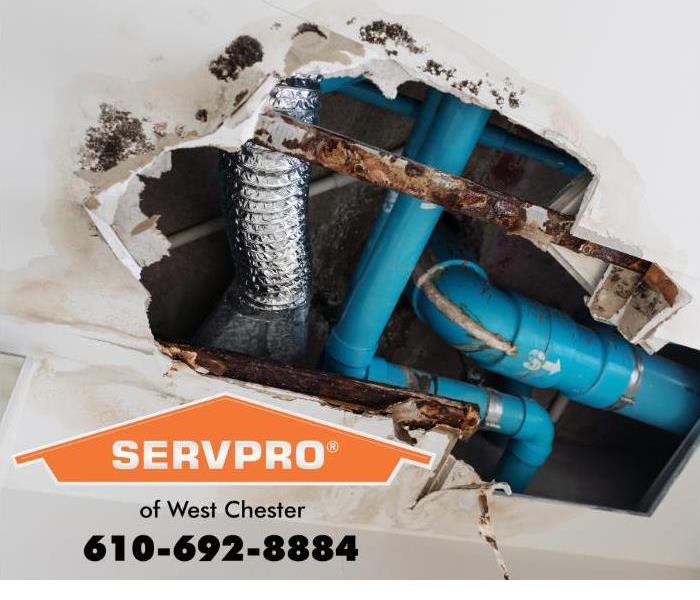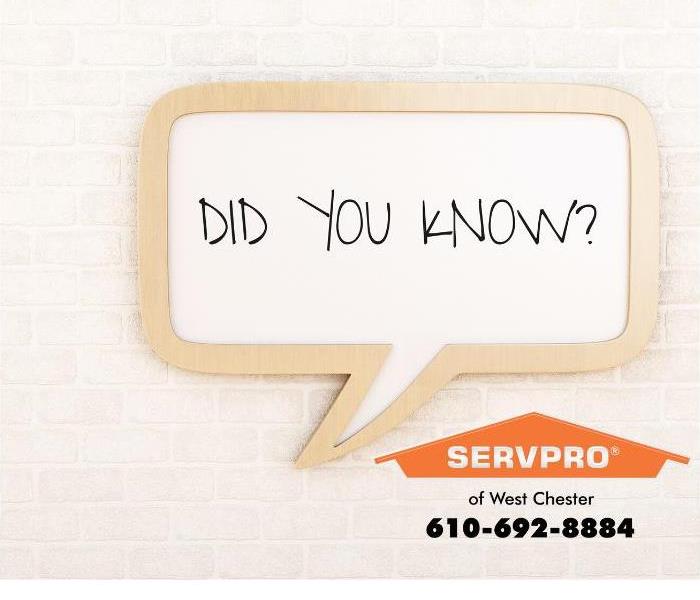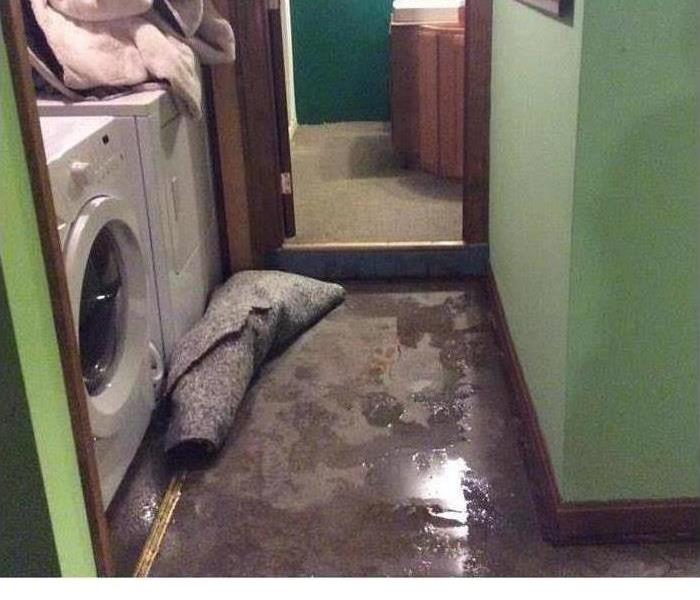Archived Water Damage Blog Posts
Do I Have a Leaky Roof?
12/8/2022 (Permalink)
 Opening an umbrella inside is just as unlucky as a leaky roof.
Opening an umbrella inside is just as unlucky as a leaky roof.
Have you ever had a leak in your roof? If so, then this article will answer the most common question that people ask themselves: "Do I have a Leaky Roof?" Leaks can be caused by many things. Sometimes they are due to age or wear and tear on the roof. Other times it is due to poor installation or other building code violations. It is hard for homeowners to know what type of leak they have without hiring an expert. That is why we compiled this list of 7 questions that can help you determine if you have a leaky roof!
First off, if you have found water, or think you have a water issue going on at your home or office, call the West Chester area’s #1 choice for water remediation. SERVPRO of West Chester/Southern Delco can be reached 24/7 at (484)-841-6669 or (610)-506-8919.
7 Questions to help determine if you have a leaky roof:
- Do I ever see water on the ground or on my ceiling?
- Is there a wet spot where water seems to be collecting?
- Does my house have a slanted roof?
- Is my attic exposed to the elements?
- Do I smell dampness or mold in my home or office?
- Do I hear running water at night when it is raining outside?
- Does the insulation in my attic look wet?
Leaks are often caused by age, wear and tear on the roof, or poor installation. Proper repair is needed to fix leaking roofs. There are new materials that have been developed to help seal leaks in roofs that can provide a more permanent solution.
SERVPRO of West Chester/Southern Delco is here to help in any way you have. Do not hesitate to reach out anytime (484)-841-6669 or (610)-506-8919 and you can speak with a professional and set up a technician to come to visit your home or business.
Preventing a Flooded Basement.
12/8/2022 (Permalink)
Water in your basement can cause damage to your walls and flooring, as well as carpets and furniture, and can harm priceless objects like photo albums, antiques, and family treasures frequently used for storage.
Water damage can be expensive to repair, whether from a plumbing leak, a roof leak, or a flooded basement. Taking the proper preparations now will save you money, time, and problems later, and it may even help you avoid massive, unforeseeable natural disasters. Here are a few home modifications that will reduce the likelihood of water damage:
Add or update drainage
Use gutters and downspouts to ensure water is diverted away from your home and its foundation. The easiest solutions to overflowing gutters are either adding another downspout on that run of gutter or increasing the size of the downspout.
Install a sump pump
Try this addition if water damage has been a severe problem in your home's lower level. Choose a cast-iron sump pump, which may last longer, and consider buying a battery-powered backup pump if the power goes out.
Seal Your Basement
This is a very logical step, but one many homeowners fail to keep up with year after year. Sealing openings to your basement means keeping weatherstripping around doors in good condition and making sure windows are caulked.
Install a water leak detection system
An automatic water shut-off valve is a water leak detection system that will shut off the water supply to the home when it detects water on the floor or an irregular flow in the pipe.
Check Your Landscaping
Although plants absorb water from the soil, they can also cause water intrusion in your basement. If they are too close to the foundation, roots may penetrate, resulting in cracks or bowing walls that allow water in. Overgrown shrubs may also restrict once-proper drainage and allow water to pool too close to your home.
Clean the Gutters
Clean the gutters on your roof to ensure that they do not overflow during a rainstorm. The downspouts carry the water away from your home, and if they are not clear of debris, the water might flow into your home's basement.
Check Your Foundation for Cracks
Check your home's foundation from the inside and outside for any cracks. If you notice small cracks, use caulk to seal them. If the cracks are extensive, you will need the help of a professional to fix them before they cause damage to your basement.
Our SERVPRO of West Chester and Southern Delaware County are Professionals in water damage restoration. We are your best option to inspect your home of standing water and get it cleaned up quickly efficiently and thoroughly. Several potential problems could arise from waiting to address standing water in your house.
Give us a call today to help avoid these concerns as much as possible. We are 24/7 Emergency Response at 610-506-8919 or 484-846-6669
Water damage destruction
9/9/2022 (Permalink)
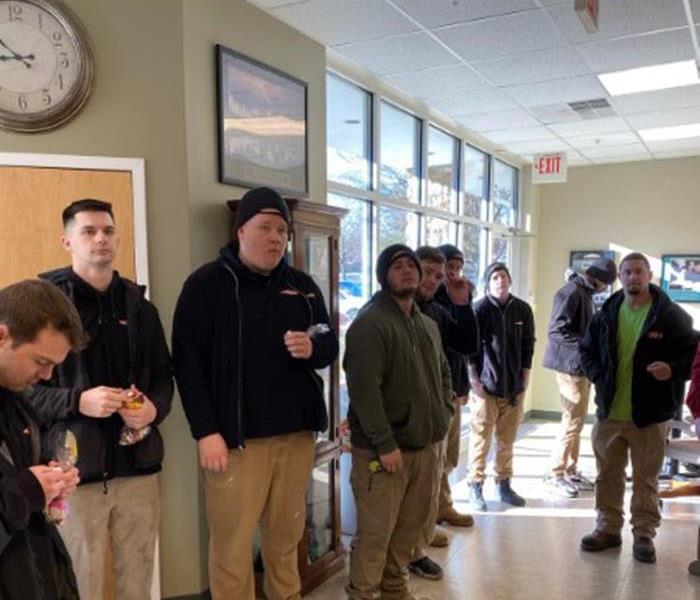 Our team, standing ready
Our team, standing ready
Water is one of the most destructive forces on Earth, and one of the most underestimated. Even the smallest trickle of water, if left unchecked, can have a devastating effect on a home or business. No matter what the cause, from a burst pipe to an overflowing appliance or a storm surge, water damage can be dangerous and even deadly.
Water is a part of life here in the area but when it becomes too much to handle, residents and business owners need a water restoration service they can turn to for professional help and that’s where SERVPRO comes in.
We are, situated inland, but we are also vulnerable to storms and bad weather
It can bring heavy rains and storm surge that lead to water damage.
SERVPRO is part of this community too, so we understand the challenges that the weather can bring and we’re prepared to respond 24/7 to help our neighbors when they’re in need.
Unlike almost any other water restoration service, we have cutting edge training that enables us to respond quickly and professionally to any size job. Once on site, we use the latest techniques and state-of-the-art equipment to handle water damage thoroughly so that your property will look “Like it never even happened”.
At SERVPRO we make it our business to respond faster to any disaster and to handle every fire restoration job with the utmost safety.
That’s the professional difference and that’s the experience you’ll get when you call SERVPRO.
With our state-of-the-art equipment and certified training you’ll know you’ve got the best in restoration by your side.
Prevent Rain Gutter Clogs and Back-up
3/2/2022 (Permalink)
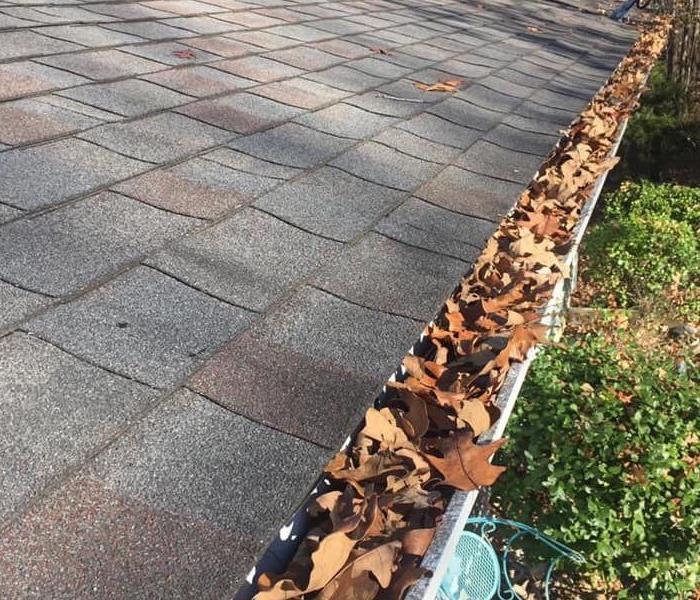 Take measures to keep your gutters clear of blockage and debris.
Take measures to keep your gutters clear of blockage and debris.
- Clear gutters of debris on a regular basis. Mother nature makes it easy for rain gutters to get clogged with items such as leaves, acorns and, twigs and branches. Take measures to regularly monitor and clear out your rain gutters.
- Be sure to keep near by trees trimmed and tidy to limit the amount of debris entering your gutters.
- Once cleared, place gutter guards or covers over rain gutters to stop debris from ever entering. Of course, small particles and items may make their way through the guards but this is a terrific step to reduce waste that ends up in your gutters.
- Make sure downspouts are cleared of any debris as well. This will limit back-up into the actual gutters.
- The design of your gutters could be causing back-up and overflow. Splash guards can be installed to prevent rain from “jumping” over the gutters.
- Ensure that your gutters are the right size and slope to maximize the efficiency of water drainage. If gutters are too small or receiving too much rain at once they will overflow and not drain properly into the downspouts.
- Keep animals and their homes out of your gutters by using non-toxic sprays or ultrasonic sound emitters.
Water Damage Emergency Tips
1/7/2022 (Permalink)
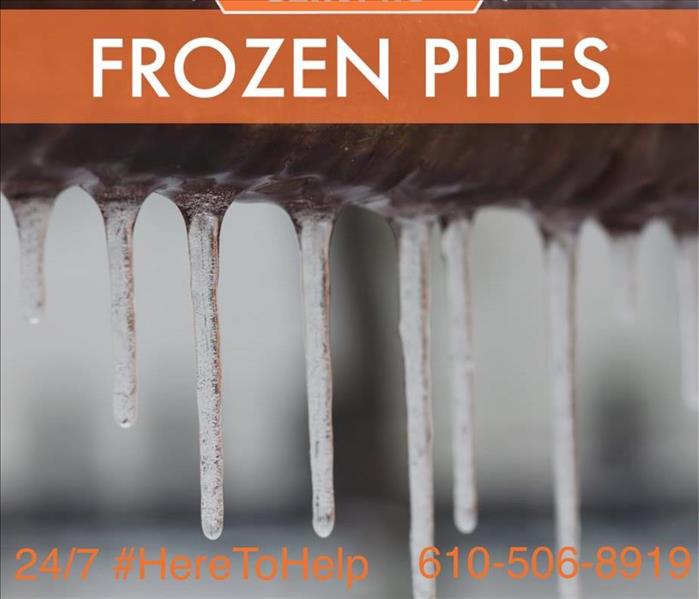 Use these tips, and call SERVPRO right away!
Use these tips, and call SERVPRO right away!
What you can do until help arrives?
After any water damage situation, your primary focus should be safety first:
- Is it safe to stay in the house?
- Electrical and "slip and fall" hazards are some of the most prevalent concerns.
- Only do activities that are safe for you to perform.
- Wet materials can be VERY heavy. Be careful!
What To Do After Flooding
- Remove excess water by mopping and blotting.
- Wipe excess water from wood furniture after removal of lamps and tabletop items.
- Remove and prop wet upholstery and cushions.
- Place aluminum foil or wood blocks between furniture legs and wet carpeting.
- Turn air conditioning on for maximum drying in summer.
- Remove colored rugs from wet carpeting.
- Remove art objects to a safe, dry place.
- Gather loose items from floors.
What NOT To Do After Flooding
- Don't leave wet fabrics in place. Hang furs and leather goods.
- Don't leave books, magazines or other colored items on wet carpet or floors.
- Don't use your household vacuum to remove water.
- Don't use television or other household appliances.
- Don't turn on ceiling fixtures if ceiling is wet, and keep out of rooms where ceilings are sagging.
Stay safe and call Danielle at 610-506-8919. SERVPRO of Southern Delaware County & West Chester has got your back! We are always here to help & faster to any size disaster. We can also help with commercial water damage, as well as home and business concerns. No job is too big for our certified mitigation team.
Types of Water Damage caused by Blizzards
1/3/2022 (Permalink)
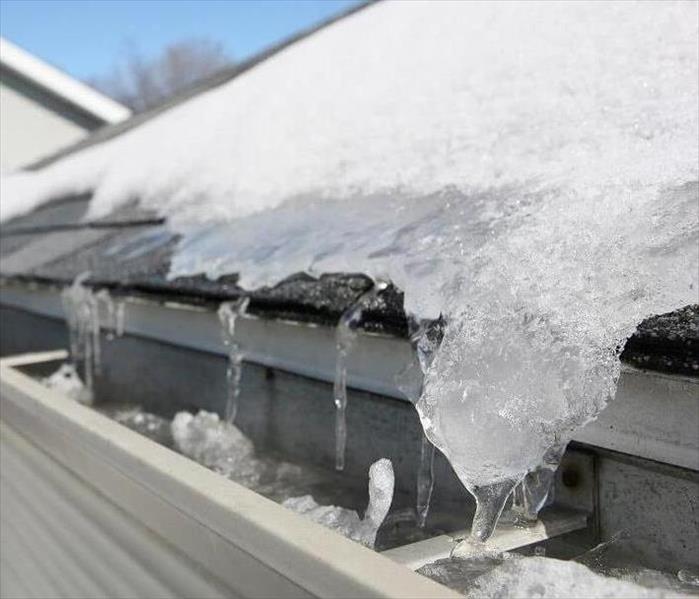 SERVPRO is #heretohelp!
SERVPRO is #heretohelp!
As we get our first snow of the season, it is important to know what type of water damage you need to be on the look out for! Here are some of the worst culprits:
Frozen Pipes Burst
Even when you’ve done all you can to winterize your home and pipes, plunging temperatures can freeze even insolated pipes. As the water inside the plumbing turns to ice and expands, it causes problems from small cracks and leaks, to complete system failure. The resulting water damage can be very severe.
Ice Dams Form on the Roof
When snow accumulates and then begins to melt and freezes into layers of ice along the roofs edge, snow dams are created. They form a thick ridge of ice, putting additional strain on already stressed roof edges, fascia, and eaves.
Roof Runoff
The damage from accumulated snow and ice on the roof can’t always be seen. But as temperatures rise and fall during the day, the snow packed on top of a house melts and then refreezes. This can cause water to seep into brickwork, siding, and even ceiling joints.
Flooded Basement
When the snow begins to thaw and melt, heavy snow and ice runoff quickly soaks yard and fills up street gutters. The soil around your foundation becomes saturated with moisture that seeps into the basement through small cracks, and can cause your basement to flood.
But have no fear, because SERVPRO of Southern Delaware County and West Chester is here to help. These things are best left up to the professionals, and SERVPRO is faster to any size disaster. Call Danielle at 610-506-8919 so we can help!
What Can Cause Condensation in your Attic?
12/9/2021 (Permalink)
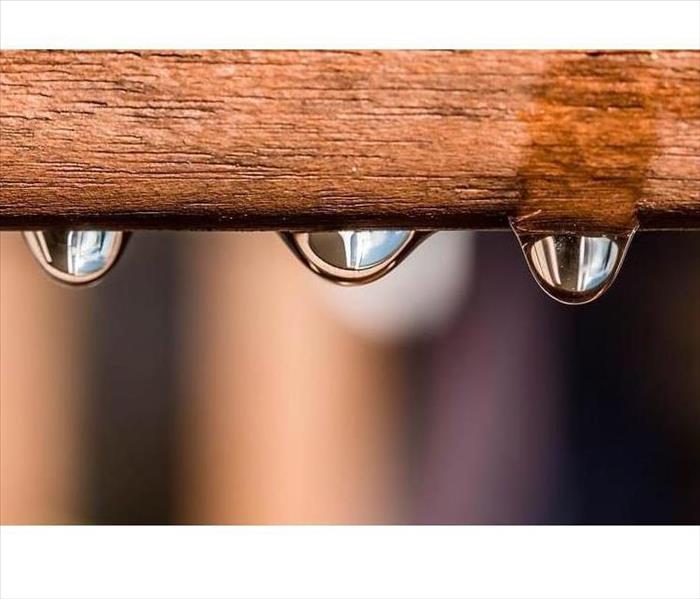 Attic condensation can cause water damage!
Attic condensation can cause water damage!
Attic condensation is a form of water damage typical to cold weather, and can be tricky to fix.
Condensation of water vapor on cold surfaces, such as in attics, can cause wood to rot. This can lead to extensive damage and very costly repairs.
Condensation in attics typically occurs when warm, moist air moves or is directed into the attic from the living spaces below in a home. Unusually high humidity in the home’s living spaces is strongly associated with attic condensation problems.
Building codes have requirements to prevent the problem of attic condensation, but unfortunately codes don’t address all the issues, and many houses are built without following building codes. Your builder or designer should understand the relationship of humidity and air movement when designing and constructing homes so that these problems don’t occur. However, if this is not the case, there are steps that you can take to prevent condensation in your attic.
Prevention
- Bathroom and kitchen exhaust fans, as well as dryer vents, should never open into the attic space. They should always discharge outside. You may have a well ventilated attic, but it won’t make a difference if the bathroom exhaust fan constantly dumps warm, moist air directly into the attic space. This could result in condensed water vapor freezing onto cold attic materials, which will eventually thaw and create wet attic materials. This will result in damage in the attic and inside the home.
- Minimize the amount of ceiling mounted fixtures below the attic. These create the need for holes in the drywall or plaster. Make sure that any of these that do exist are properly sealed. They need to be airtight.
- Keep your attic air temperature below freezing when the outside air temperature is in the low 20s. Proper attic ventilation is key to keeping the attic cool, while insulation keeps the rest of your house warm. You have to keep vents free from obstructions so that the natural flow of cool outside air is not hindered, and can replace the warmer attic air that rises. The flow of air will keep the attic cool and free of moisture build-up.
If you do experience any water damage this winter, give Danielle a call at 610-506-8919 so that SERVPRO of Southern Delaware County & West Chester can help!
What Causes Pipes to Burst? And How to Prevent It!
12/8/2021 (Permalink)
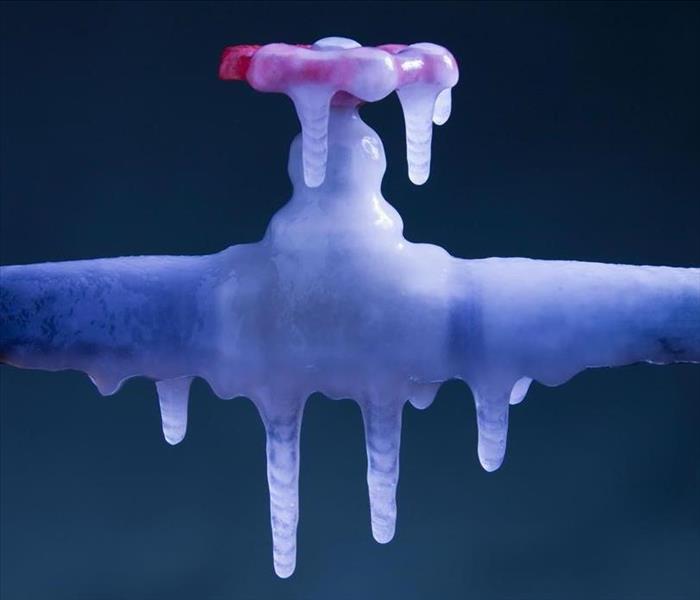 If you have frozen or burst pipes, we can help!
If you have frozen or burst pipes, we can help!
Although cold weather may seem less threatening than a rainstorm or a hurricane, it can cause water damage, as well. It’s important to understand the threat of water damage from freezing weather so you can recognize the signs and try to prevent or mitigate as quickly as possible!
Frozen or Burst Pipes
External faucets and plumbing in unheated areas within your house, such as in your garage, crawlspace, attic, basement, or kitchen cabinets are at the highest risk. Pipes exposed to severe cold such a hose bibs, swimming pool supply lines, and water sprinkler lines are at high risk, as well. You also have to watch out for pipes that run against exterior walls that have little or no insulation.
Prevention
You can prevent frozen pipes by applying heat tape or insulation. You can also keep faucets at a slight trickle to avoid pressure build-up, and fully turn off your water if you leave town and won’t be using it for an extended amount of days. Be sure to drain water from swimming pool and water sprinkler supply lines following manufacture directions. Remove, drain, and store hoses inside for the winter. Close inside valves supplying outdoor hose bibs. Open hose bibs to allow water to drain and then keep the outside valve open so that any water remaining is able to expand without causing the pipe to break. You can also open kitchen and bathroom cabinets to allow warmer air to circulate around the pipes. Keep the thermostat set to the same temperature both during the day and night, and if you go away during cold weather - it may incur a higher heating bill, but will prevent a much more expensive repair due to frozen or burst pipes!
If you do experience any water damage this winter, give Danielle a call at 610-506-8919 so that SERVPRO of Southern Delaware County & West Chester can help!
The High Cost of Water Damage
8/3/2021 (Permalink)
The High Cost of Water Damage
Each year water causes billions of dollars in property damage and the longer water damage is left untreated the higher will be the cost of repairs. Exterior repairs can help protect your home’s exterior. Water will naturally find the path of least resistance and will seep inside structures through damaged irrigation systems, broken downspouts, leaking roofs, failing seals around windows and doors and from severe weather events and snowmelt. SERVPRO® of Southern Delaware County & West Chester offers these tips form the Insurance Information Institute to repair and protect your home’s exterior from water damage:
- Caulk and seal windows
- Inspect your roof for missing, damaged and aging shingles and make necessary repairs
- Remove debris that may have accumulated in downspouts and rain gutters
- Position downspouts so that they direct water away from the house
- Check sprinklers and irrigation systems to be sure they are not creating water damage to the walls and foundations of the house
- Turn off and drain outside faucets to protect against frozen pipes
- Install gutter guards to prevent gutter clogs and keep water flowing away from the house
Call Us Today
If you experience a water damage emergency, SERVPRO® of Southern Delaware County & West Chester is ready to respond 24 hours a day, every day, and can be onsite in four hours to begin the cleanup and restoration process. Call us today at 610-506-8919. We’ll clean and restore your water damage “Like it never even happened.”
SERVPRO® of Southern Delaware County & West Chester is Independently Owned and Operated.
Call Danielle 610-506-8919
How do I Dry a Water Leak?
5/28/2021 (Permalink)
The immediate aftermath of a severe water leak can be daunting.
Many surfaces, from books and furniture to floors and walls, can be damaged by water and that initial damage can lead to mold and mildew growth if not addressed quickly and thoroughly.
Since mold growth can begin within 48 hours after water damage occurs, it is crucial to begin the remediation process immediately and specific guidelines should be followed in order to ensure that the job is done correctly.
While it is generally a good idea to rely on professional remediation services, there are some steps you can take to begin the process yourself:
The best way to begin the drying process is by moving air. You can do this both naturally, by opening windows and doors, as well as mechanically, using fans.
The size and amount of fans you need will depend on the amount of area that is involved; the larger the room, the more powerful the fan you’ll want to use. You can rent high-powered fans to speed up the process even more.
In a contained area, like a basement or rec room, with limited outside access, you can remove excess humidity with a portable dehumidifier.
Shut the doors and windows of the room and remember to change the water collection drawer of the humidifier regularly if it doesn’t self-drain.
If there are several inches of standing water, a portable sump pump can be used to move the water out of the house.
Direct the hose of the pump out a door or window and make sure the water flow is directed away from the foundation of the house.
For smaller areas with less standing water, a wet/dry shop vac can help to suck up the excess. They can be particularly useful for salvaging water-damaged carpeting and flooring.
Never use a regular household vacuum on wet surfaces as this could damage the vacuum and be careful when emptying the canister of the shop vac, particularly if the water involved is contaminated with sewage or other potentially hazardous material.
Remove Water Damaged Furnishings
Any objects that have been damaged by water, including rugs, furniture, and other belongings, should be removed and set in the sun to both begin the drying out process and reduce the moisture level in the room.
Sheet vinyl or linoleum flooring should also be removed to speed up the evaporation process.
Any wet insulation underneath water damaged flooring or inside walls should be removed and discarded.
Remove and Carefully Dry Papers
Books and papers that become wet may not be salvageable, but for important items you can help prevent mold growth and slow the deterioration process by placing them in a plastic bag and putting them in a frost-free freezer.
Aside from this step, it will be necessary to handle paper items carefully in order to preserve them, including cleaning them off with soft brushes and using rubber gloves for your protection.
Once standing water has been removed, you can use desiccants such as silica gel, clay, or calcium oxide to absorb any remaining moisture. Place the desiccant in either an air-tight container or a sealed area such as a closet. It may take days or even weeks for them to become completely saturated.
Act Quickly To Avoid Hazards
Again, the faster you act to begin drying out a water damaged room, the better your chances of avoiding water-related hazards, including mold growth, dust mites, and the release of non-microbial chemicals from formaldehyde-treated wood furnishings, plastics or PVC. Scientific evidence shows that these hazards can cause serious health effects.
Call The Professionals
Because water damage can permeate beneath the surface of floors and walls and continue to be an issue for days or even weeks after the original emergency, it makes the most sense to trust a professional water mitigation company like SERVPRO.
With extensive training, professional equipment, and the ability to respond immediately whenever disaster strikes, SERVPRO can ensure that your home is thoroughly dried out and returned to normal as quickly as possible.
It’s particularly important to have professional water mitigation when walls are damaged, as drywall can act as a wick and absorb moisture.
Even if the water damage isn’t visible, it can still lead to mold growth if it isn’t properly treated.
At SERVPRO we’re:
- trained to get beneath the surface, using specialized equipment such as moistures meters,
- infrared imaging devices and
- heavy-duty dehumidifiers and fans to ensure that your home is thoroughly dry and safe for your whole family.
When water damage occurs, getting the affected area dried out as quickly as possible is crucial.
To ensure the safety of your family, make sure you undertake the drying process properly, and don’t hesitate to call on the reliable water mitigation professionals at SERVPRO.
Call Danielle 610-506-8919
Does Water Damage Happen Immediately?
5/26/2021 (Permalink)
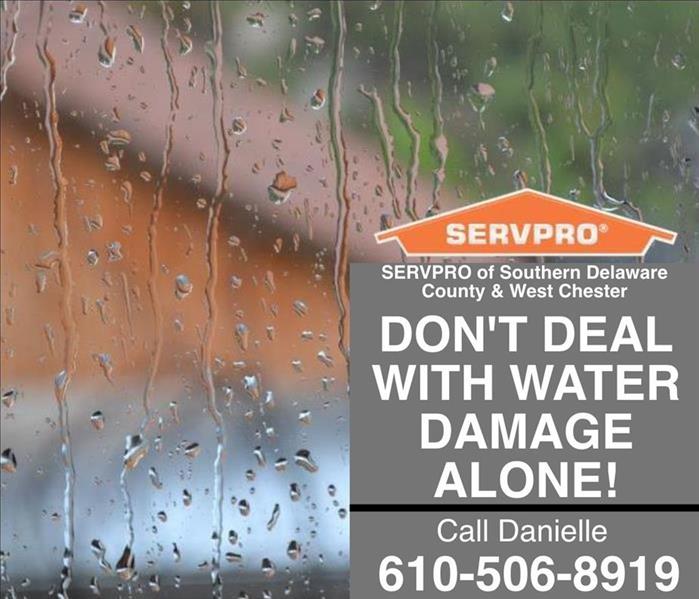 Call Danielle 610-506-8919
Call Danielle 610-506-8919
Water is one of the most destructive forces on Earth
It only takes a small amount of water to cause extensive damage, but just how quickly does that damage occur?
While some of the effects of water are immediate, there are other effects that may take days or even weeks to become apparent.
The extent of water damage depends on how long the water is allowed to stand or accumulate, but even after you stop the immediate cause there can still be lingering effects.
For this reason, it is imperative that you recognize exactly how water can affect your home and how to properly clean up after a water related emergency to prevent further damage.
Water Damage Within Minutes
The first signs of water damage will be to carpeting, fabrics and furniture items that come in contact with standing water. Porous materials like carpeting, fabric and paper will soak up and retain water, causing them to become discolored and begin to swell.
Furniture that is standing on carpeting will begin to leech and stain the carpeting.
The first step in repairing the damage is to identify the source of the water and resolve it if possible.
In the case of a burst pipe or leak, shutting off the water supply to your home should do the trick.
If the cause is flooding from a storm then you’ll need to wait until the storm is over and begin removing the standing water as safely and quickly as possible.
Water Damage Within Hours
Even if you are able to quickly cut off the source of the problem, damage can still occur within hours of first contact with water.
As the humidity level rises, odors become apparent and fabrics that are not colorfast will begin to bleed, potentially staining other materials they come in contact with.
Furniture and other wooden objects begin to chip, peel and swell.
In order to mitigate the damage to furniture and other wood surfaces, steps should be taken to remove the items and begin drying them out as soon as possible.
In most instances, you’ll want to proceed cautiously, allowing the items to air dry to prevent the damage from getting any worse.
If the damage is too severe, items may not be salvageable.
Water Damage Within Days
By far the biggest risk related to water damage is the growth and spread of mold and fungi.
Mold requires moisture to grow, so as soon as surfaces become wet they provide the perfect environment for mold.
Mold will begin to grow within 24 to 48 hours after water exposure occurs and once it begins to grow it can spread rapidly and may cause health effects.
After flooding occurs, you’ll need to confirm that conditions are safe in order to begin cleanup, which includes checking for signs of mold growth.
The EPA has guidelines to follow in order to determine the safety of any structure for flood cleanup.
Other damage that can occur within days of flooding includes severe warping and cupping of wood floors, blistering of paint and peeling of wallpaper as adhesives start to release.
Wood structural beams and other underlying parts of your home may also begin to swell, warp and split.
Water Damage Within Weeks
The damage caused by flooding can take as long as several weeks to become apparent and may be severe if immediate steps are not taken to thoroughly dry and clean the affected area.
To prevent spread, you should have your home’s HVAC system thoroughly checked and treated as this is the primary way that mold can infect an entire house.
Structural beams, floors, and ceilings may be drastically affected, making the home unsafe for occupancy.
The Red Cross recommends carefully checking your home for any structural damage after a flood before you begin the cleanup.
Trust The Pros To Make Repairs
Water damage can be devastating and it can continue to be a problem long after the immediate emergency is resolved.
To protect your home and family against the lingering effects of water damage, you need to ensure that the affected area is completely dried and cleaned.
While you may be able to handle some of this process yourself, you don’t want to take risks and that’s why it’s important to hire water mitigation professionals to ensure that the job is done right.
At SERVPRO, we’re prepared to respond immediately and we have the expertise and equipment necessary to get the job done right every time.
We’ll remove any badly damaged items and make structural repairs to ensure that your home is safe.
As devastating as flooding can be, not all water damage is immediately apparent.
To keep your home safe, stay one step ahead of water damage by trusting cleanup and restoration to the professionals.
Call Danielle 610-506-8919
Water Damage
3/2/2021 (Permalink)
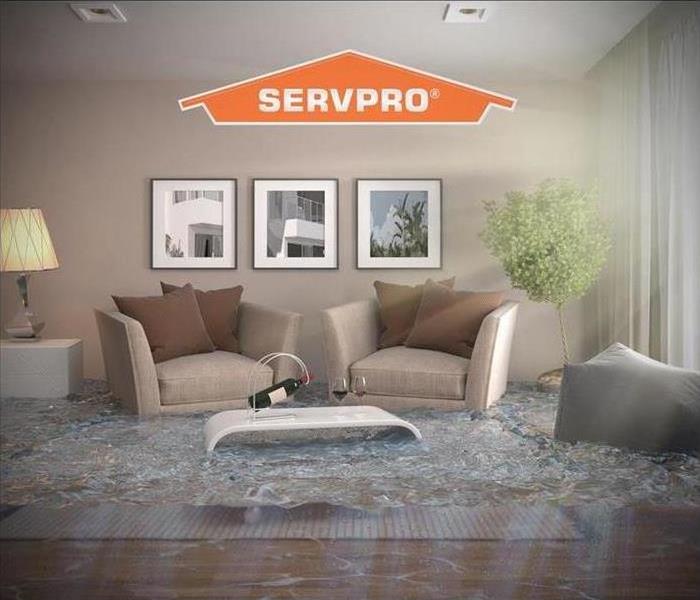 Call Danielle 610-506-8919
Call Danielle 610-506-8919
A broken valve on a pipe can release a torrent of water causing major damage to your business before you know it. It is imperative that water damage be mitigated as soon as possible to prevent costly structural building repairs. SERVPRO® of Southern Delaware County & West Chester can respond to any disaster within 24-hours, seven days a week and we want to help. We will begin the cleanup and restoration process immediately to get your business back to normal as quickly as possible. Our six-step process for water cleanup and restoration includes:
- Step 1: Emergency Contact
- Step 2: Inspection and Water Damage Assessment
- Step 3: Water Removal
- Step 4: Drying and Dehumidification
- Step 5: Cleaning & Sanitizing
- Step 6: Restoration
Depending on the amount and type of water damage, we may provide some of these services:
- Caring For Your Belongings
- Storm Damage
- Mold Remediation
- Sewage Cleanup
- Building Services
- Commercial Water Damage
Our highly trained technicians have the specialized equipment necessary to safely clean and restore damage for residents and business owners. Call us today at 610-506-8919 to find out about our water cleanup and restoration services. We hope you never have water damage to your home or business but if you do, SERVPRO of Southern Delaware County & West Chester wants to help. We use advanced technology and techniques and we are available 24 hours a day. We’ll take care of your damage “Like it never even happened.”
SERVPRO of Southern Delaware County & West Chester is independently owned and operated.
Call Danielle 610-506-8919
Winter Weather
12/27/2020 (Permalink)
Cold weather can have a huge impact on your home or business if you are not ready for it. From heavy rain and freezing temperatures, to damaging winds, sleet, or snow, all can cause serious and costly property damage. While you cannot control the weather, you can take steps to be prepared and help take the sting out of winter weather.
To help prevent costly damages due to weather, consider taking the following precautions to protect your property before colder weather hits.
- Check your home or business property for downed tree limbs and branches. Wind, heavy rain, ice, and snow can cause branches to fall, which could cause damage to the property and potentially cause personal injuries.
- Roofs, water pipes, and gutters should all be inspected to ensure they are in proper order. Gutter downspouts should be directed away from your building. Clear gutters of debris that may have gathered during the fall. Leaves and other obstructions can cause a damming effect, which can lead to roof damage and interior water problems.
- Inspect property, especially walkways and parking lots, for proper drainage to alleviate flood hazard potential.
- Inspect all handrails, stairwells, and entryways to address and correct potential slippery or hazardous areas. Install mats or non-slip surfaces and post caution signs where water could be present.
- Protect water pipes from freezing by simply allowing water to drip when temperatures dip below freezing. If pipes are under a cabinet, leave the cabinet doors open, allowing warm inside air to circulate around the pipes. If the building has outdoor faucets, consider shutting water off at the main valve in the basement or crawl space. Once the valve is off, open the outdoor faucet to ensure it drains, preventing any remaining water from freezing in the pipe.
- Ask SERVPRO of West Chester about completing an Emergency Ready Plan (ERP) for your business. The ERP is a no-cost assessment to your facility and provides you with a plan to get back in business fast following a disaster.
Call Danielle 610-506-8919
Winter Storms
12/27/2020 (Permalink)
SERVPRO of West Chester has these tips to help prepare for a winter storm.
Winter Storms can bring high winds, snow, and ice. A winter storm can knock out power, water, and communication.
SERVPRO of West Chester wants you to be prepared. Winter storms can last anywhere from a few hours to several days.
You can’t prevent a winter storm, but you can minimize storm damage.
- Prepare by gathering emergency supplies. Supplies include warm clothes, extra blankets, flashlights, medicines, and food. Gather any items you will need if you lose power or communication
- Develop a communication plan. Have phone numbers written down in case you cannot use your mobile phone
- Know the winter storm terms. The National Weather Service (NWS) will report a(n):
- ADVISORY when they expect that weather conditions might be hazardous. Be cautious, and the conditions should not be life-threatening
- WATCH when they predict heavy snow or ice, but cannot yet show when or which areas will be hit. NWS issues a WATCH 12 to 26 hours ahead of the predicted storm
- WARNING when they expect 4 or more inches of snow or sleet within 12 hours or they expect ¼ inch or more of ice. Keep warm and dry. Minimize driving. Stay indoors
- Tell your local electric company if someone in your home needs power for medical devices. They will make your home a priority
- Install battery-powered or battery back-up carbon monoxide detectors.
Remember, prevention is the best solution to water damage, but if disaster strikes, SERVPRO is Here to Help.
Call Danielle 610-506-8919
Winter Storms
12/27/2020 (Permalink)
SERVPRO of West Chester has these tips to help prepare for a winter storm.
Winter Storms can bring high winds, snow, and ice. A winter storm can knock out power, water, and communication.
SERVPRO of West Chester wants you to be prepared. Winter storms can last anywhere from a few hours to several days.
You can’t prevent a winter storm, but you can minimize storm damage.
- Prepare by gathering emergency supplies. Supplies include warm clothes, extra blankets, flashlights, medicines, and food. Gather any items you will need if you lose power or communication
- Develop a communication plan. Have phone numbers written down in case you cannot use your mobile phone
- Know the winter storm terms. The National Weather Service (NWS) will report a(n):
- ADVISORY when they expect that weather conditions might be hazardous. Be cautious, and the conditions should not be life-threatening
- WATCH when they predict heavy snow or ice, but cannot yet show when or which areas will be hit. NWS issues a WATCH 12 to 26 hours ahead of the predicted storm
- WARNING when they expect 4 or more inches of snow or sleet within 12 hours or they expect ¼ inch or more of ice. Keep warm and dry. Minimize driving. Stay indoors
- Tell your local electric company if someone in your home needs power for medical devices. They will make your home a priority
- Install battery-powered or battery back-up carbon monoxide detectors.
Remember, prevention is the best solution to water damage, but if disaster strikes, SERVPRO is Here to Help.
Call Danielle 610-506-8919
What is an Ice Dam?
12/11/2020 (Permalink)
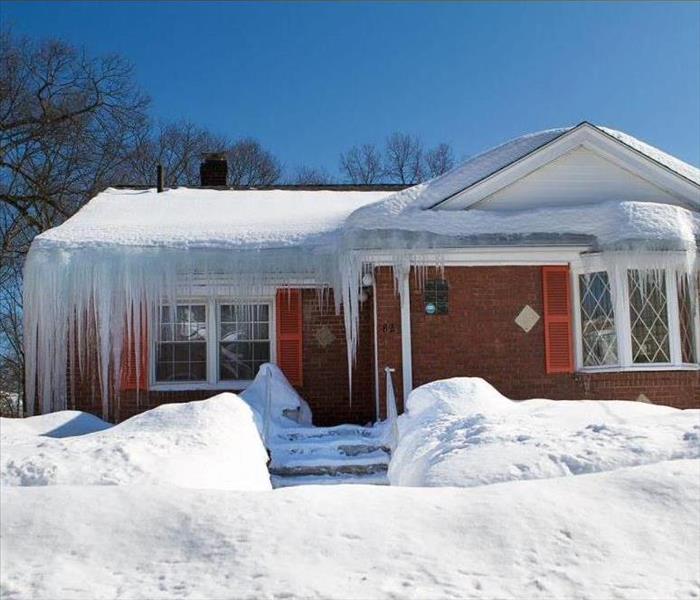 Call Danielle 610-506-8919
Call Danielle 610-506-8919
An ice dam is a ridge of ice that forms at the edge of a roof and prevents melting snow (water) from draining off the roof. The water that backs up behind the dam can leak into a home and cause damage to walls, ceilings, insulation and other areas.
Moisture entering the home from ice dams can lead to the growth of mold and mildew. These can cause respiratory problems.
- Prevent the growth of mold and mildew by immediately drying out portions of the house that are wet or damp.
- Take immediate action to get rid of the water source, clean the home environment and maintain its air quality.
Heat loss from a house, snow cover and outside temperatures interact to form ice dams. For ice dams to form there must be snow on the roof and, at the same time, higher portions of the roof's outside surface must be above 32 degrees F (freezing) while lower surfaces are below 32 degrees. These are average temperatures over sustained periods of time. For a portion of the roof to be below freezing, outside temperatures must also be below freezing.
The snow on a roof surface that is above freezing will melt. As water flows down the roof it reaches the portion of the roof that is below 32F and freezes. This causes the ice dam.
The dam grows as it is fed by the melting snow above it, but it will limit itself to the portions of the roof that average below 32F. So the water above backs up behind the ice dam and remains a liquid. This water finds cracks and openings in the exterior roof covering and flows into the attic space. From the attic it could flow into exterior walls or through the ceiling insulation and stain the ceiling finish.
If you experience any fire, water, or mold damage, call Danielle at 610-506-8919.
Frozen Pipes
11/11/2020 (Permalink)
With the cold weather right around the corner, it raises concern about pipes freezing in homes and businesses. When pipes freeze, it leaves a huge mess of water damage to your homes and businesses. That is when you call SERVPRO to help you clean up the mess and fix the areas that were damaged from the water. Here at SERVPRO, we make it our job to make sure that the customer is happy with the outcome of the job.
Here are a couple things that will help to prevent your pipes from freezing:
- Keep your home or apartment thermostat temperature set to at least 55 degrees.
- Do not block heat to areas of your residence that contain plumbing or water fixtures. Keep doors open to bathrooms, kitchens, laundry rooms, and cabinets that contain pipes, especially those located on the north side of the dwelling, to expose the plumbing to warmer air inside the house.
- Prevent drafts of cold winter air by keeping windows and storm windows closed. Repair cracks or holes around doors and windows to keep cold air from blowing in.
- Cover pipes in unheated areas with heat tape or pipe insulation.
If you plan to be away from your residence for an extended period of time, ask someone to check your house or apartment periodically. Show them what to do if water pipes freeze and where to locate your water shut-off valve in case of an emergency
Call Danielle at 610-506-8919
Causes of Water Damage
11/11/2020 (Permalink)
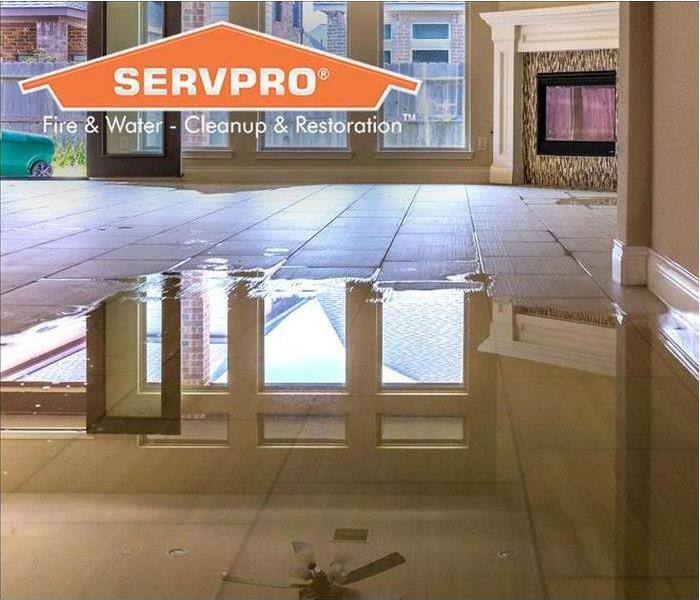 Call Danielle 610-506-8919
Call Danielle 610-506-8919
Water damage occurs when excess water begins to pool in areas where it shouldn’t. Many different factors can create this excess water and thereby contribute to water damage. When you are aware of the potential causes, you can take precautionary measures to help insure against a leak or flood. You will also be able to spot a problem as soon as it arises and nip it in the bud before it has a chance to cause any additional damage. The more quickly you notice the problem, the less work the water extraction and water damage restoration company will have to fix.
Causes of water damage include:
- Bursting or leaking pipes
- Issues with the plumbing system
- Buildup in areas prone to collecting water, such as crawl spaces, attics and basements
- Faulty or malfunctioning household appliances
- HVACs (Heating, ventilating and air conditioning units) issues
- Natural disasters and other weather-related water problems
If you are experiencing water damage, call Danielle at 610-506-8919. SERVPRO of West Chester is here to help!
Classes of Water Damage
11/10/2020 (Permalink)
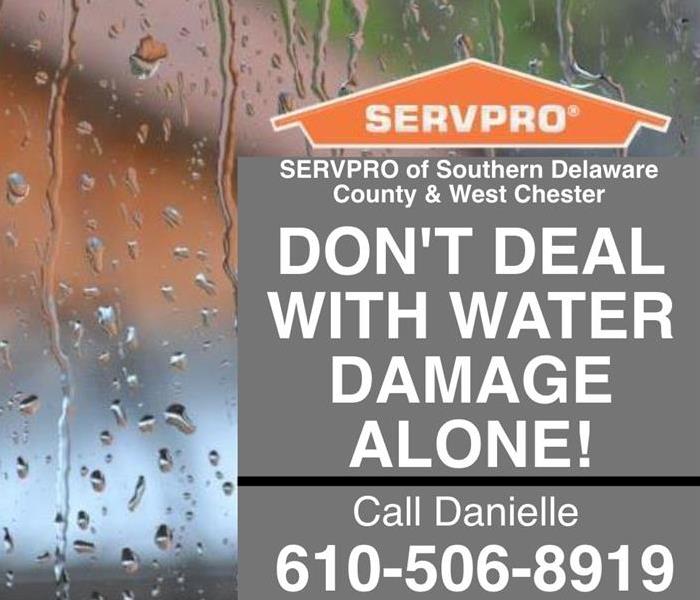 Call Danielle 610-506-8919
Call Danielle 610-506-8919
Classes of water losses are determined by the rate of evaporation based on the type of materials affected by water damage to your property. Determining the Class of Water is an important first step, and will determine the amount and type of equipment utilized to restore your business. There are four water damage classifications, they are as follows:
Class 1 - Slow Evaporation Rate
Water losses that affect only part of a room or area, or losses with lower permeance/porosity materials (e.g., plywood, particle board, structural wood, vinyl composition tile or VCT, concrete). Little or no wet carpet or cushion is present. Minimum moisture is absorbed by materials, releasing moisture slowly.
Class 2 - Fast Evaporation Rate
Water losses that affect an entire room or carpet and cushion. Water has wicked up walls 12" - 24". There is moisture remaining in structural materials (e.g., plywood, particle board, structural wood, concrete).
Class 3 - Fastest Evaporation Rate
Water may have come from overhead. Ceilings, walls, insulation, carpet, cushion and sub-floor in the entire area are saturated.
Class 4 - Specialty Drying Situations
These consist of wet materials with very low permanence/porosity (hardwood, plaster, brick, concrete, stone, and crawlspace). Typically, there are deep pockets of saturation, which requires very low specific humidity.
If you experience water damage, call Danielle at 610-506-8919
Finding all of the Water in Your Home After a Water Loss
10/8/2020 (Permalink)
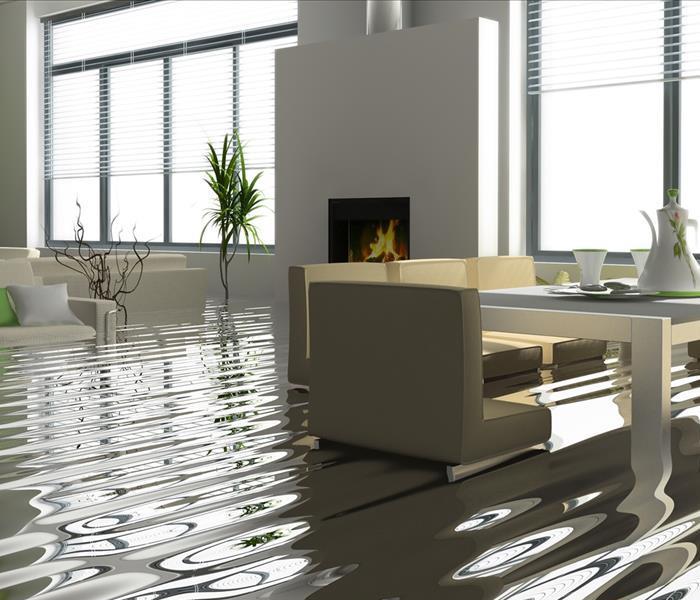 If you experience a water loss, call Danielle 610-506-8919
If you experience a water loss, call Danielle 610-506-8919
Finding all of the water in your home after a water loss is critical for drying and safety.
Even sanitary water or clean water left standing can become contaminated within days. The longer the water is able to sit and get soaked into materials the greater the damage and the more extensive remediation and repairs. After a water loss, make sure to check these critical places for water or moisture:
- Ceilings of rooms under the source
- Walls
- Floors
- Wet insulation
- Duct systems
- Crawl spaces
- Basements
Here at SERVPRO of West Chester, we know how overwhelming a water loss can be. This is why we are here to give tips to help you through the process. When your home or business is affected by water damage, call SERVPRO of West Chester for a trustworthy restoration team. We are here to help your home or business go back to normal. For any fire, mold, or water damage, call Danielle. 610-506-8919
Minimizing Water Damage
10/7/2020 (Permalink)
 Call Danielle 610-506-8919
Call Danielle 610-506-8919
When it occurs, water damage is a significant problem for business owners. SERVPRO West Chester is here to help when this problem strikes. We are here to educate business owners to on how to handle water damage and minimize its devastating effects.
Water Damage Basics
Some of the possible causes of water damage:
- Storm
- Flood
- Poor Ventilation
- Leaking Pipes
- Excessive Condensation
- High Humidity
- Damp Utility Closets
- Roof Leaks
- Damp Carpets
- Fire Sprinklers
Once water damage occurs on your property, you need to figure out where the water came from, the extent of the damage and how long the property has been damaged.
When dealing with water damage, immediate action is crucial. SERVPRO of West Chester professionals respond immediately and use advanced equipment and techniques to remove the water quickly. They closely monitor and document the drying process to verify your property is dried properly and thoroughly.
Your commercial property’s appearance speaks volumes to your clients. So, when the need arises for professional cleaning or emergency restoration services, SERVPRO of West Chester is the one to call. In any water, storm, fire, or mold damage, call us 24/7/365. 610-506-8919
The Real Reason That Pipes Burst When They Freeze
12/17/2019 (Permalink)
The real reason why frozen pipes burst is because of the increase in pressure on the side of the pipe where the frozen section is. As there is less space available between the ice and the closed tap that is “upstream,” the pressure spikes—which causes the bursting to happen.
Many people assume that the cause of pipe bursting is simply due to the freezing - “Because water expands when it freezes.” Water molecules take on a hexagonal form during freezing, which takes up more volume than liquid form. However, when water in a pipe expands due to freezing, it expands to the sides, not directly outward. So, this isn’t the direct cause of the pipe freeze.
Not all frozen pipes burst. However, thawing the ice can increase the risk, as it usually worsens the problem since it raises the pressure further. This is why pipe bursting is especially common at the end of winter when the ice starts to thaw.
Winter weather puts a remarkable number of stresses on a home, which is why you should take special precautions to winterize it against the chill, especially your pipes. One way to prevent pipes from freezing is by adding insulation on the exposed piping (usually the pipes around the water heater). This will prevent the pipes from losing too much heat to the cold air around them, that they freeze.
Causes of Water Damage
11/11/2019 (Permalink)
Water damage occurs when excess water begins to pool in areas where it shouldn’t. Many different factors can create this excess water and thereby contribute to water damage. When you are aware of the potential causes, you can take precautionary measures to help insure against a leak or flood. You will also be able to spot a problem as soon as it arises and nip it in the bud before it has a chance to cause any additional damage. The more quickly you notice the problem, the less work the water extraction and water damage restoration company will have to fix.
Causes of water damage include:
- Bursting or leaking pipes
- Issues with the plumbing system
- Buildup in areas prone to collecting water, such as crawl spaces, attics and basements
- Faulty or malfunctioning household appliances
- HVACs (Heating, ventilating and air conditioning units) issues
- Natural disasters and other weather-related water problems
Frozen Pipes
11/11/2019 (Permalink)
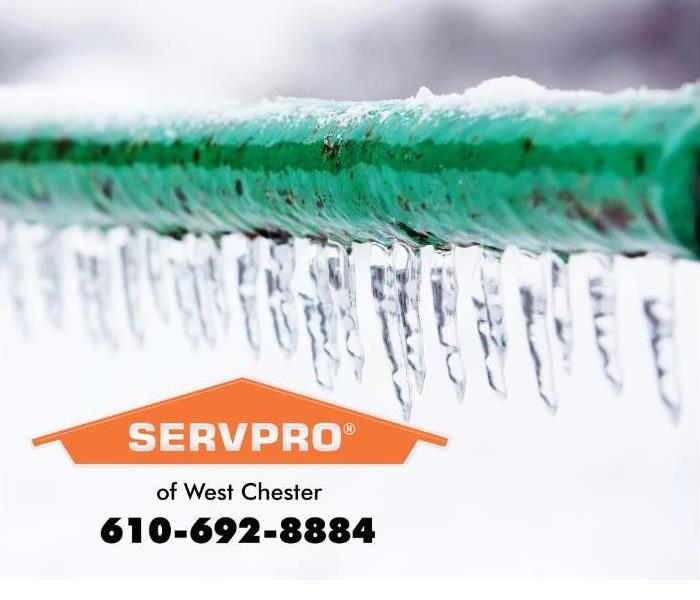 Be proactive so that you don't have to deal with the mess of frozen pipes this winter season. If you do need us though, SERVPRO is here to help!
Be proactive so that you don't have to deal with the mess of frozen pipes this winter season. If you do need us though, SERVPRO is here to help!
With the cold weather right around the corner, it raises concern about pipes freezing in homes and businesses. When pipes freeze, it leaves a huge mess of water damage to your homes and businesses. That is when you call SERVPRO to help you clean up the mess and fix the areas that were damaged from the water. Here at SERVPRO, we make it our job to make sure that the customer is happy with the outcome of the job.
Here are a couple things that will help to prevent your pipes from freezing:
- Keep your home or apartment thermostat temperature set to at least 55 degrees.
- Do not block heat to areas of your residence that contain plumbing or water fixtures. Keep doors open to bathrooms, kitchens, laundry rooms, and cabinets that contain pipes, especially those located on the north side of the dwelling, to expose the plumbing to warmer air inside the house.
- Prevent drafts of cold winter air by keeping windows and storm windows closed. Repair cracks or holes around doors and windows to keep cold air from blowing in.
- Cover pipes in unheated areas with heat tape or pipe insulation.
If you plan to be away from your residence for an extended period of time, ask someone to check your house or apartment periodically. Show them what to do if water pipes freeze and where to locate your water shut-off valve in case of an emergency
The Four Classes of Water Damage
11/8/2019 (Permalink)
Classes of water losses are determined by the rate of evaporation based on the type of materials affected by water damage to your property. Determining the Class of Water is an important first step, and will determine the amount and type of equipment utilized to restore your business. There are four water damage classifications, they are as follows:
Class 1 - Slow Evaporation Rate
Water losses that affect only part of a room or area, or losses with lower permeance/porosity materials (e.g., plywood, particle board, structural wood, vinyl composition tile or VCT, concrete). Little or no wet carpet or cushion is present. Minimum moisture is absorbed by materials, releasing moisture slowly.
Class 2 - Fast Evaporation Rate
Water losses that affect an entire room or carpet and cushion. Water has wicked up walls 12" - 24". There is moisture remaining in structural materials (e.g., plywood, particle board, structural wood, concrete).
Class 3 - Fastest Evaporation Rate
Water may have come from overhead. Ceilings, walls, insulation, carpet, cushion and sub-floor in the entire area are saturated.
Class 4 - Specialty Drying Situations
These consist of wet materials with very low permanence/porosity (hardwood, plaster, brick, concrete, stone, and crawlspace). Typically, there are deep pockets of saturation, which requires very low specific humidity.
How to Prevent Mold In Homes in West Chester
10/21/2019 (Permalink)
Mold spores can be found anywhere, and usually don’t cause any problems. . However, when mold grows indoors, exposure to it can cause different health problems as well as property damage. That’s why mold prevention should be a priority for any homeowner. In order to understand how to prevent mold, it’s important to know how and why it forms in the first place.
Mold only forms when the conditions are just right. It takes three different ways to make the conditions right for mold to grow. The first condition is food. This would mean anything that used to be alive (wood, cardboard, paper, wool, silk, leather, etc.). The next condition would be temperature mold thrives in the range of 68°F to 86°F. This can be especially tricky considering this is the same range we typically keep our homes. The final condition is water. Very little is needed. In fact, the Environmental Protection Agency (EPA) says that indoor humidity above 60% is enough to allow mold to develop.
There are certain steps you can take to prevent mold from forming. There are many ways to help control moisture and prevent mold growth in your home. If you can see or smell mold, eliminate the excess moisture, then clean and remove any mold. It’s very important to quickly identify and correct any moisture sources before health and structural problems develop. Call SERVPRO of West Chester immediately if you have any water damage, or find mold in your home.
Carpet Damage in West Chester
10/18/2019 (Permalink)
Have you ever been somewhere where the carpets smell? You may automatically think that the carpets are just old, and need to be cleaned. Have you ever been somewhere where the carpets never smelled, and ended up smelling on a different day? That could mean mold! Especially if you had previous water damage.
The first thing you should ever do if you get unexpected water in your home, is to call SERVPRO of West Chester. The most important thing is to immediately get the water properly cleaned up. If it is a pipe that was leaking, or an appliance, it is important to get the source of the problem fixed, to stop the water from coming back in, or to keep the water from coming in. The next step would be to get the water cleaned up, as soon as possible. This will be crucial to what will be able to be saved, if anything at all. It would then be important to dry the water up fast. This would be to prevent the water from further sitting, and causing more damage or mold.
The next step would be to steam clean everything that was affected by the water. Then to sanitize everything, to make sure there is less room for mold to grow. Mold can be very dangerous, and making sure it is out of your carpets, is very important for your health. Getting mold into your carpets, or underneath, would cause so many issues, especially to your health. Remember, in the unfortunate event that you experience water damage, or feel as if your carpets are smelling in your home after water damage, call SERVPRO of West Chester.
What You Should Do if your Washing Machine Floods
1/3/2019 (Permalink)
Washing machines use up to thirty gallons of water to clean our clothes on a regular basis. If this convenient device were to flood, however, there would be extensive water damage to your home. Disaster can strike when we least expect it, so it’s best to have some knowledge of what to do if you experience this problem.
How to Fix the Problem
Cut off the electrical power supply to the washer at the fuse box. Don’t stop the washer or immediately pull the electrical plug since doing so can lead to more flooding and possible electric shock.
Remove the clothes from the washer and drain them in the sink to remove some of the water from the washer.
Check to see if the washer hoses are leaking water. Tighten the hot and cold water supply hoses, and ensure that the drain hose is properly in place.
Test the washer without laundry or detergent to ensure the problem is solved.
To prevent your washer from flooding, do not put an excessive amount of laundry in the washer during a cycle, and make sure the machine was not recalled.
A water disaster can stem from a small problem, such as a washer leak. If you experience any water damage in your home, SERVPRO of West Chester can handle the loss for you and restore your property to its preloss condition.
SERVPRO Quickly Establishes a Drying Plan Based on the Initial Assessment
10/9/2018 (Permalink)
Any time water gets inside your residence, removing the excessive moisture within 48 hours is essential. If wood or paper materials stay wet for longer, then microbial formation can take place. Water can also saturate contents and building materials inside your home ruining them.
After something like a pipe break or an appliance malfunctioning takes place and causes water to flood your house, extraction occurs to pull out any standing water and moisture inside porous materials. The next step in any water removal project is the drying process. Rapid drying of contents and structural components is essential to prevent secondary damage and mold growth.
Before drying begins, the area gets tested to determine the extent of damage the moisture has caused. Our SERVPRO technicians check the temperature, relative humidity, and moisture content of wood and drywall. Once we figure out how wet the region got, we can formulate a drying plan.
The initial drying plan includes how many air movers and dehumidifiers get set up in the affected area. The plan also indicates drying goals. The drying goals are set by determining what the conditions were before the loss took place.
The ending goal is determined by coming up with a dry standard. To establish a dry standard, humidity, temperature, and the moisture content of drywall and wooden materials in unaffected areas of the building get tested. Once the standard is designated as the drying goal, our IICRC certified team uses their knowledge and experience to determine the right pieces of drying equipment to rapidly dry out moisture until it is back to preloss conditions.
How Can I Protect My Home from Water Damage?
9/6/2018 (Permalink)
Preventing water damage is a whole lot cheaper than paying for repairs. Here are 3 easy prevention tips:
*Ensure good drainage
clean your gutters
direct downspouts 5-10' away from the house
slope your yard away from the foundation
*Test your sump pump
check your sump pump once a year
test more frequently during storm season
*Fix water leaks
repair any noticeable dripping pipes
check for dark spots under pipes and on ceilings
repair any cracked caulking
inspect the roof for missing, loose, or damaged shingles
Water damage is the #1 culprit that can weaken your home's foundation and the very core that holds your house together.
What to Do When Your Basement Floods
9/6/2018 (Permalink)
A flooded basement can give any homeowner a feeling of helplessness and panic. If this happens to you, try not to over-analyze the situation - it may not be as bad as you think. Here's some tips you can use if you find your basement flooded.
*make sure to shut off any power around the area, including electricity and gas. NEVER enter a flooded area while the power is on
*take action as soon as you notice flooding, unless the water is caused by rain. In this case, wait until it's passed before getting to work
*if your basement has a floor drain, check to make sure it didn't become clogged. Keeping it open and working will help drain the water
*start removing water by using a sump pump, pool pump, or wet/dry vacuum - depending on the amount of water
*move damaged items out of the basement to dry in a well ventilated area
You may want to call a professional for help if the water was more than several feet deep or if you see mold or mildew developing.
Preserving Valuable Assets and Documents
7/21/2017 (Permalink)
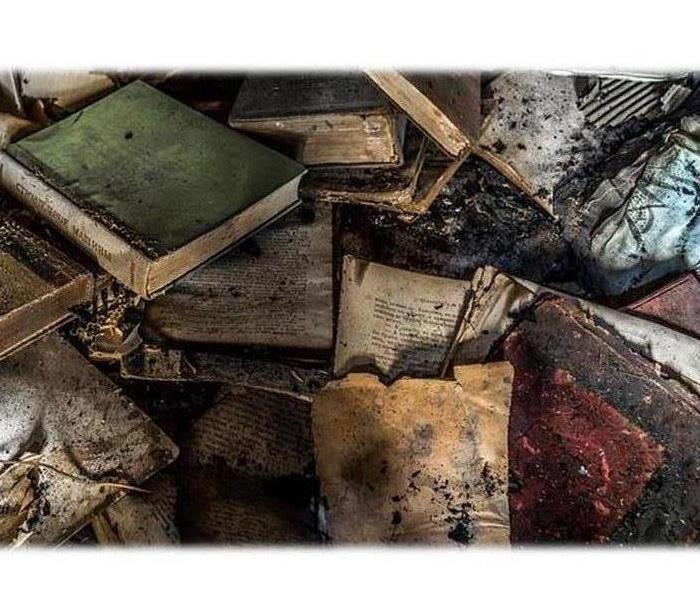 Don't despair, SERVPRO of West chester has the technology available to resurrect wet documents and valuables.
Don't despair, SERVPRO of West chester has the technology available to resurrect wet documents and valuables.
Day in and day out, your customers and employees trust you with their sensitive documentation, valuable client information, financial & legal records, blueprints, engineering drawings, medical or government files and sometimes personal artifacts. From a security standpoint, you may already keep these valuable assets and files under lock and key for compliance purposes, and hopefully they are scanned in a protected file as back-up.
Yet what happens if your office or home is faced with smoke, soot, mold, water damage from a pipe bursting or an overhead sprinkler erratically going off over the weekend? Much more than the structure becomes affected. Everything, including furniture, upholstery, electronics, paintings and even important documents may need immediate CPR, and a comforting dose of tender loving SERVPRO care.
Residents of the Greater West Chester area can breathe a sigh of relief. WHY? Thankfully the technology exists today to save, salvage and restore valuable furniture, documents, photos, equipment and computers in many cases. If your business or even home experiences an issue that impacts the structure and/or contents of the property, remember to stay calm. Just call SERVPRO of West Chester (SPWC) we're right around the corner.
SPWC will walk you through every step including interfacing with your insurance claim adjuster or agent to identifying clearly the steps needed to clean, preserve or refinish the items that are especially meaningful to you personally or critical to your business.
DID YOU KNOW that SPWC can arrange to have damaged documents receive the vacuum freeze-drying service to assist in the recovery of these important documents and other media?
SERVPRO of West Chester will review a series of steps that will take place during this preservation process such as cleaning, digitizing, sterilizing (through gamma irradiation), deodorizing, and certified destruction services, if needed. Even on large Category 3 losses or items affected by microbial growth from dirty or sewage water, a drying chamber can help recover items. The freeze drying chamber can dry almost 800 cubic feet of documents in each cycle. The standard run time for that size of a load is about 4-8 days depending on the nature of the items and the amount of moisture that is in them. Most drying chamber teams are available 24/7, 365 days a year to assist with customer concerns, HIPAA certifications, proper shipping, and the drying process.
Getting a customer back to normal is the Number 1 priority.
If you experience a water disaster, SERVPRO of West Chester recommends these easy steps before help arrives.
- Shut off the water. If you can't manage this, get a neighbor to quickly help you.
- Only when the access to the power distribution panel is safe, turn off circuit breakers for the wet areas.
- Use a wet vac to suck up as much clean water as possible. Stay away from any “dirty” water (sewage-related).
Celebrating our 26th anniversary serving the West Chester area, SERVPRO of West Chester is proud to be a long-time Greater West Chester Chamber member. We understand the disruption fire, water or mold damage causes to your life. Our goal is to help minimize the interruption and quickly make it "Like it never even happened." SERVPRO of West Chester specializes in the cleanup and restoration of residential and commercial properties from deep cleaning or readying a property for sale to mitigating mold, mildew and pet odors. Reach us 24/7 at 610-692-8444 or at jeannie@SERVPROwestchester.com.
Water Damage Can Ruin Your Day
5/23/2017 (Permalink)
When water damage affects your home, response time is very important. The longer you wait to remedy the issue, the further the water damage can spread to other areas of your home. If you’re looking for a company to assist you with removing the water damage, look no further than SERVPRO of West Chester We have years of experience in dealing with water damage and know exactly what to do to put your home back together.
Our call center recently received a call from a homeowner in West Chester requesting our water damage remediation services. The homeowner told us that her plumber had found a pinhole leak in a copper line. He let her know that she’d need to contact a water damage remediation company for assistance in removing the resulting water damage. When she asked if he could recommend anybody, the plumber referred her to SERVPRO of West Chester.
After talking to the homeowner on the phone, we immediately sent our Project Manager, Blake Quinn out to inspect the damage. He found that the leak had caused damage to two bedrooms, the hallway and living room. He knew that this was the perfect project for SERVPRO of West Chester, so Blake Quinn contacted the rest of our crew and asked them to make their way over to the home.
When the rest of our team arrived, we first removed the affected drywall and carpet pad. Fortunately, we were able to dry out the affected tile flooring and carpet. To make sure that all the water damage was completely gone, we set up heavy-duty drying equipment in all the affected areas.
The homeowner was very impressed with our staff. She thanked them for being so knowledgeable and helpful in removing the water damage from her home. We were happy to help!
If water damage is ruining your home, contact SERVPRO of West Chester for help. Call us today and we’ll remove the damage from your home in no time at all!
When water damage affects your home, response time is very important. The longer you wait to remedy the issue, the further the water damage can spread to other areas of your home. If you’re looking for a company to assist you with removing the water damage, look no further than SERVPRO of West Chester We have years of experience in dealing with water damage and know exactly what to do to put your home back together.


 24/7 Emergency Service
24/7 Emergency Service














